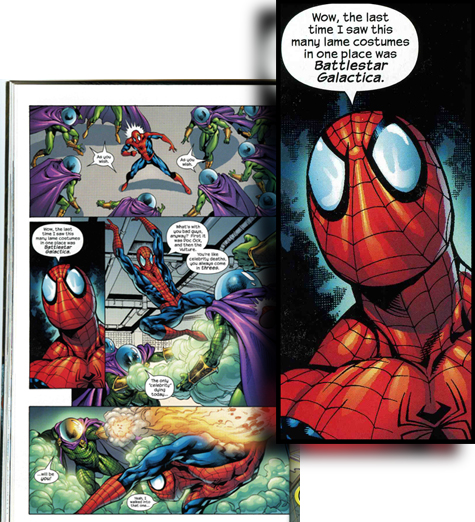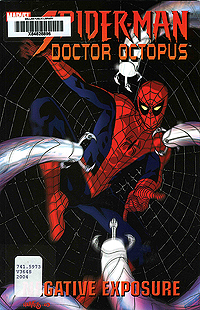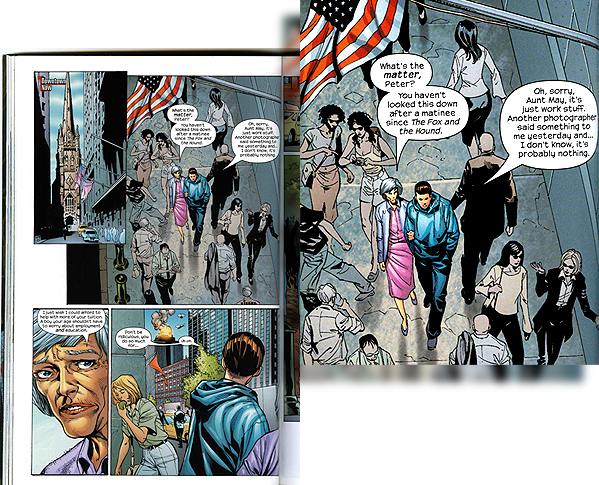
 Apparently even Marvel Comics' most popular superhero Spider-Man is a fan of LDS filmmakers.
Apparently even Marvel Comics' most popular superhero Spider-Man is a fan of LDS filmmakers.
Within the space of just a few pages, Peter Parker (as Spider-Man) and his Aunt May refer to two movies made by Latter-day Saint filmmakers in the graphic novel Spider-Man/Doctor Octopus: Negative Exposure. (Written by Brian K. Vaughan. Pencil art by Staz Johnson. Inks by Danny Miki. Published by Marvel Comics. First printing 2004. Presents material originally published in magazine form as: Doctor Octopus: Negative Exposure #1-5.)
The inclusion of two such references was probably inadvertent. I doubt that author Brian K. Vaughan was intentionally stacking his dialogue with LDS film references. (Vaughan, who was born Cleveland, Ohio in 1976 and currently lives in San Diego, California, began writing comics professionally in 1999 and quickly became one of the hottest, most in-demand writers in the business.)
The 5-issue limited series Doctor Octopus: Negative Exposure was published decades after Spider-Man first appeared, but it presents a story that takes place not in Spider-Man's contemporary continuity, but in his early formative years, while the character was still a high school student. The focus of the story is actually less on Peter Parker/Spider-Man, and more about a rival photographer at the Daily Bugle whose obsession with getting one of his photos on the front page of the newspaper drives him to assist the villainous Doctor Octopus.
The five issues of the limited series were collected in a graphic novel format and published in 2004 as Spider-Man/Doctor Octopus: Negative Exposure.
The first reference is a wisecrack that Spidey makes while battling Mysterio. While battling this special effects wizard-turned-super villain, Spider-Man is confronted with dozens of holographic copies of Mysterio. Spider-Man jokes:
Wow, the last time I saw this many lame costumes in one place was Battlestar Galactica.The TV series and feature film "Battlestar Galactica" were, of course, written and produced by famed LDS TV producer Glen A. Larson. Moreso than any of Larson's many other TV projects, "Battlestar Galactica" incorporated Larson's Latter-day Saint beliefs and background. Peter Parker, interested more in science than science fiction, was probably unaware of this fact.
This quote is from Doctor Octopus: Negative Exposure issue #3, page 14.

A few pages later in the single volume "graphic novel" version of this limited series (but actually from issue #4, page 11 of Doctor Octopus: Negative Exposure), Aunt May refers to the time that a younger Peter Parker went to see the Disney animated movie "The Fox and the Hound":
What's the matter, Peter? You haven't looked this down after a matinee since The Fox and the Hound.

Aunt May doesn't mention it, but "The Fox and the Hound" was one of two theatrically released Disney animated feature films that were helmed by Latter-day Saint animation director Richard Rich. (The other was "The Black Cauldron.") Rich got his professional start in the animation business working at Disney, and even collaborated with fellow Latter-day Saint Disney animation professional Don Bluth on some projects, most notably "The Small One" (about the donkey that carried Mary to Bethlehem for the birth of Jesus; with music by Latter-day Saint composer Robert F. Brunner and voice acting by Latter-day Saint actor Gordon Jump). But Richard Rich didn't stay at Disney much longer after making "The Fox and the Hound" and "The Black Cauldron." He founded his own animation studio, and went on to direct dozens of made-for-video films for children based on the Bible, the Book of Mormon, and American history. He also directed numerous animated feature films, including "The Swan Princess", "The King and I" and "The Trumpet and the Swan." It is not known whether Spidey has seen any of these.
Of course, every true Latter-day Saint fan of Spider-Man knows that the ultimate source for Latter-day Saint-related Spider-Man content is the limited series Spider-Man: The Lost Years (1993), by acclaimed writer J. M. DeMatteis. The whole story in this 3-issue limited series is set in Salt Lake City, Utah, and the most important supporting character in the storyline is a devout Latter-day Saint police detective named Jacob Raven.
Spider-Man: The Lost Years preceded the release of Richard Dutcher's film "God's Army" by 7 years, yet shared many of that film's central themes and plot elements.
The character of Jacob Raven went on to appear in at least 19 other issues of various Spider-Man comics, but none were as well-written and worth reading as the introductory tale by DeMatteis.